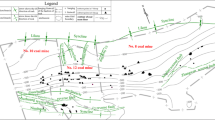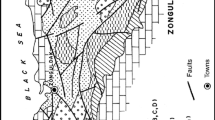Abstract
On January 29ty, 1986, the third largest gas outburst in Japan took place at Sunagawa Coal Mine, which is the only hydraulic mine in Japan. It occurred at a face of a cross-cut, just after a coal seam was outcropped by blasting for drivage of the cross-cut. The site of the gas outburst was located 1,180 m below the surface. No workers were injured, but the cross-cut was plugged with 1,600 m3 of coal fragments extending over 100 m behind the face and 60,000 m3 of methane gas was emitted.
The site of the gas outburst was investigated in detail to clarify the geological features. A normal and a reverse fault existed at the site. The area of the ejected zone was about 400 m2 and extended upward along the normal fault. The shape of the ejected zone suggests a great role of the normal fault on the gas outburst.
Digital seismograms, recorded by a mine-wide seismic array at the coal mine, consisting of 27 microseismic events were used to investigate the gas outburst. Magnitude, seismic energy release, distribution of hypocenter and focal mechanism were analyzed. Taking the shape of the ejected zone together with results of the seismological investigation into consideration, it appears that the seismicity started with left-lateral faulting of the reverse fault and then right-lateral faulting of the normal fault followed. The faulting of the normal fault might be the direct cause and be the predominant mechanism of the gas outburst.
Similar content being viewed by others
References
Aki, K. andRichards, P. G.,Quantitative Seismology: Theory and Methods, Vol. 1 (W. H. Freeman and Co., San Francisco 1980) pp. 170–185.
Gibwicz, S. J. (1975),Variation of Source Properties: The Inangahua, New Zealand, aftershocks of 1968, Bull. Seism. Soc. Am.65, 261–276.
Gutenberg, B. andRichter, C. F. (1956),Magnitude and energy of earthquakes, Ann. Geofis. (Rome)9, 1–15.
Isobe, T., Sato, K., Mori, N., andGoto, T.,Microseismic activity induced by hydraulic mining of steeply inclined coal seams, InThird Conference on Acoustic Emission/Microseismic Activity in Geologic Structures and Materials (eds. Hardy, H. R. and Leighton, F. W.) (Trans Tech Publications, Clausthal 1984) pp. 403–424.
McGarr, A., Green, R. W. E., andSpottiswoode, S. M. (1981),Strong ground motion of mine tremors: Some implications for near source ground motion parameters, Bull. Seism Soc. Am.71, 295–319.
Spottiswoode, S. M.,Source mechanisms of mine tremors at Blyvooruitzicht Gold Mine, InProceedings of the 1st International Congress on Rockburst and Seismicity in Mines (eds. Gay, N. C. and Wainwright, E. H.) (South Afr. Inst. Min. Metall., Johannesburg 1984) pp. 29–37.
Author information
Authors and Affiliations
Rights and permissions
About this article
Cite this article
Sato, K., Fujii, Y. Source mechanism of a large scale gas outburst at Sunagawa Coal Mine in Japan. PAGEOPH 129, 325–343 (1989). https://doi.org/10.1007/BF00874513
Received:
Revised:
Accepted:
Issue Date:
DOI: https://doi.org/10.1007/BF00874513




